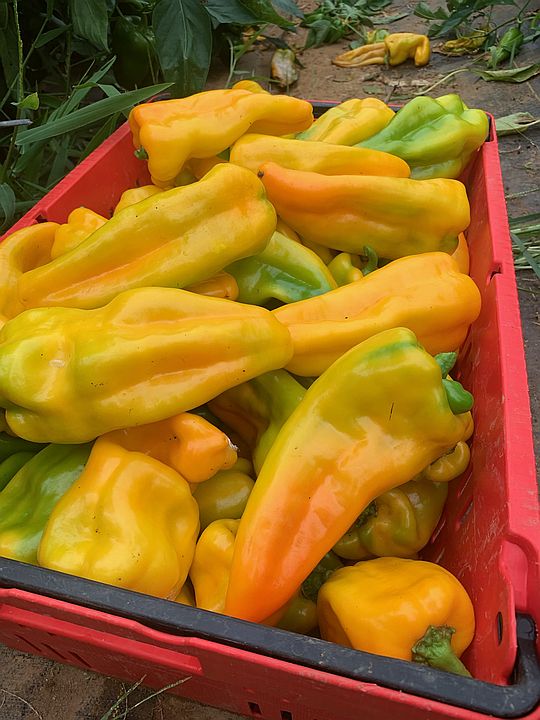New in the shares this week are long beans! Long beans are eaten like green beans, but they are in the same family as purple hull peas. They are sweeter, softer and meatier than green beans. You can prepare them as you would green beans. They are an Asian vegetable and lend themselves well to stir-fry. I like to stew mine with tomatoes, which is also one of my favorite ways to eat okra and eggplant, too. Long beans do have a short shelf life compared to green beans and can get dry and spongy in storage, so it is best to use them in the next few days.
Bumper Crops
Every year farming is a journey into the unknown. Working with living things in a natural system results in marvelous complexity. We plan and we plant and we tend and we harvest and then we scratch our heads and think, “huh, that’s an awful lot of yellow squash.” There have been some bumper crops this year, and squash has certainly been one of them. I hope you have enjoyed the challenge of eating all that squash.
The peppers have also done very well in the high tunnel. One of the great things about peppers is that they are super easy to freeze. If you have more peppers than you need right now, simply chop them up and freeze them. No blanching necessary. They stay loose when frozen, so it is easy to grab what you need out of the bag for winter chilis, gumbos, or whatever. If you have some peppers that have been sitting around for a week or two and are starting to get soft they should still be perfectly good. The softening is just the pepper losing water.
A Thorny Problem
Last week we mowed down the cover crop. This was not the plan. The plan was to let the cover crop grow for another month. We didn’t even get to see the sunflowers bloom! But there was just too much spiny pigweed growing in the cover crop to let it go. A typical spiny pigweed plant produces over 100,000 seeds. That’s a lot of weed seeds. By mowing it down and disking it in before the seeds can mature, we are helping our future selves avoid some really significant weed problems.
I know where all that pigweed comes from; it comes from the cotton burr compost that we apply to the field. The cotton burr compost is great for the soil. It improves the soil structure, which results in better drainage and lighter soil that dries out faster, crusts less and is easier to work. But it comes at a price. That price is introducing spiny pigweed to the farm. I still think the cotton burr compost is worth it. Ask me again in a few years and see if I’ve changed my tune.
Small Shares
- Okra
- Eggplant
- Slicing Tomatoes
- San Marzano Tomatoes
- Yellow Squash
- Long Beans
- Sweet Peppers
Full Shares
- Okra
- Eggplant
- Slicing Tomatoes
- Juliet Plum Tomatoes
- Yellow Squash
- Long Beans
- Sweet Peppers
- Basil




You must be logged in to post a comment.